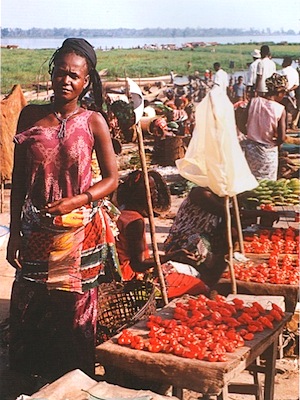
By 1482, the Portuguese had settled the western “Gold Coast“ of Africa, and by 1505 they had colonized Mozambique on the east coast. By 1510 they had seized Goa in India and had established a colony there. During this time, it is suspected chile peppers were introduced by way of trade routes between Lisbon and the New World. By 1508, Portuguese colonization of the Pernambuco region of Brazil meant that both the annuum and chinense chiles prevalent there were made available for importation into Africa. The introduction of sugar cane into Brazil in the 1530s and the need for cheap labor was a cause of the trade in slaves, and an active passage of trade goods between Brazil and Africa sprang up.
The most likely scenario for the introduction and spread of chile peppers into Africa south of the Sahara is as follows. Varieties of Capsicum annuum and chinense were introduced into all West and East African Portuguese ports during the 40 years between 1493 and 1533, with the introduction into West Africa logically preceding that of East Africa. The chiles were first grown in small garden plots in coastal towns by the Portuguese settlers and later by the Africans. Although it is has been suggested that chiles were spread throughout Africa by Europeans during their search for new slaves, the simplest answer is the best. The Portuguese may have been responsible for the introduction of chiles into Africa, but spreading them was for the birds. History–and evolution–repeated themselves. Precisely in the same manner that prehistoric chiles spread north from South to Central America, chiles conquered Africa.
African birds fell in love with chile peppers. Attracted to the brightly-colored pods, many species of African birds raided the small garden plots and then flew further inland, spreading the seeds and returning the chiles to the wild. Chiles thus became what botanists call a subspontaneous crop–newly established outside of their usual habitat, and only involuntarily spread by man. From West Africa, birds moved the peppers steadily east, and at some time chiles either reached the coast of East Africa or met the advance of bird-spread chiles from Mozambique and Mombasa. They also spread chiles south to the Cape of Good Hope. We must remember that these chiles were being spread by birds centuries before the interior of Africa was explored by Europeans. So when the early explorers encountered chiles, it was only natural for them to consider the pods to be native to Africa.
A nineteenth century traveler to Angola, Joachim Monteiro, commented on the wild chiles he saw there. “It grows everywhere in the greatest luxuriance as a fine bush loaded with bunches of the pretty bright green and red berries. It seems to come up spontaneously around the huts and villages, and is not otherwise planted or cultivated…. It has a most violent hot taste, but the natives consume it in incredible quantities; their stews are generally of a bright-red colour from the quantity of this pepper added, previously ground on a hollow stone with another smaller round one. Their cookery is mostly a vehicle for conveying this chili pepper.”
This bird-planting cultivation was still evident in 1956 when Pierre de Schlippe, a senior research officer at the Yambio Experimental Station in the Congo, reported that chiles had become the most important cash crop after cotton in the Zande district with, as he put it, “very little encouragement and no supervision whatsoever.“ When he asked a Zande tribesman whether he preferred chiles to cotton as a cash crop, the farmer replied, “Do the birds sow my cotton?“ De Schlippe noted in his book on the Zande system of agriculture that the tribesman was suggesting that one should never do for oneself what others will do. “It is safe to assume that chiles as a cash crop had no influence on agricultural practice whatever,“ wrote De Schlippe.




